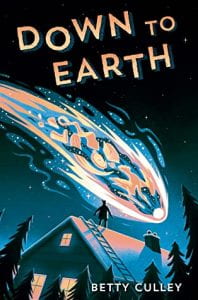 Ormsbee, Kathryn. Growing Pangs. Random House, 2022. 978-0-593-30129-6. 249 p. $20.99. Grades 4-7.
Ormsbee, Kathryn. Growing Pangs. Random House, 2022. 978-0-593-30129-6. 249 p. $20.99. Grades 4-7.
As a homeschooled kid with bright red hair, freckles, and crooked teeth, Katie knows she is a little different from most kids her age. But as long as she has her best friend Kacey, none of that matters. The pair head off to spend their summer at Camp Aldridge, and that’s when things begin to change. Katie notices that Kacey gets very jealous when Katie hangs out with other people at camp. When they both start at their homeschool co-op for the year, Katie’s circle of friends continues to grow while Kacey shrinks back into the sidelines of Katie’s life. One aspect of Katie’s life that hasn’t gotten smaller is the “buzzing” in her mind. The buzzing orders her to accomplish tasks like turning a faucet on and off ten times. If she completes the task, nothing bad will happen to Katie or the people in her life. When Katie finds out she needs oral surgery and that Kacey is moving away before their friendship can be repaired, the buzzing gets louder and louder. Katie realizes she needs help from her parents to take control of her Obsessive Compulsive Disorder.
THOUGHTS: Katie is insightful for her age yet also relatable. Her struggles mirror the pressure and anxiety tweens face every day. This semi-autobiographical graphic novel will most definitely appeal to fans of Raina Telgemeier and the Sunny series.
Graphic Novel Danielle Corrao, Manheim Central SD
Sixth-grader Katie Ormsbee has a lot going for her. She’s homeschooled and enjoys a busy schedule full of theater, music lessons, gymnastics, church, and weekly homeschool co-op. She’s very close with her bestie, Kacee, though there’s tension when Katie expands her circle to include some new friends. In addition to some typical preteen drama (braces! a bad haircut!), Katie experiences “buzzing thoughts,” which artist Molly Brooks depicts through bees buzzing around Katie’s head. “They told me what to do like a big, buzzing bully,” Ormsbee writes. These intrusive thoughts, which are outlined in thick lines resembling storm clouds, manifest in compulsions such as tying and retying her shoelaces, or turning the faucet on and off ten times. The thoughts tell Katie that these actions will prevent bad things from happening, and repeating them does make her feel better … but only for a little while. As the thoughts become more difficult to live with, Katie’s parents realize that she needs professional counseling to help her cope. As Katie begins to understand her anxiety and Obsessive Compulsive Disorder, she also discovers that she isn’t as alone or “weird” as the thoughts have made her feel. This absorbing graphic novel is divided into four seasons, with color palettes and early-2000s clothing to match. Katie is an appealing protagonist throughout; even when she’s hurting, she’s thoughtful and kind.
THOUGHTS: Growing Pangs (inspired by Katie Ormsbee’s own childhood) really captures the tween years, especially the role of friendship and feelings of isolation, with the additional layer of mental health issues.
Graphic Novel Amy V. Pickett, Ridley SD

